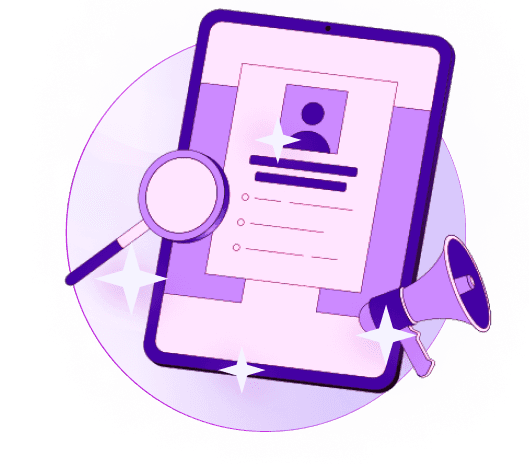Blogs
Articles

What is Buyer Intent Data and How to Use Buyer Intent Data?
Did you know that 95% of buyers are not solution-seeking? What is buyer intent data and why should we care? The measurable information shows a prospect's actions and behaviors that help us understand their likelihood to buy.
B2B organizations face a challenge today. While 71% collect buyer signals, more than half fail to utilize this valuable data. This creates a significant missed chance, particularly since buyers spend only 17% of their purchasing trip meeting potential vendors. B2B marketers point to poor quality data as their biggest hurdle, with 42% saying it blocks their lead generation efforts.
This piece will explain buyer intent data clearly. You'll learn where to find it and how it can reshape your B2B marketing and sales strategy.
What is Buyer Intent Data?
Buyer intent data shows how likely customers are to buy something based on their online behavior. This data reveals if a prospect is ready to make a purchase by tracking their actions and how they interact during the buying process.
Market intelligence (also called purchase intent data) tracks the digital footprints of people and businesses as they search and interact online. These behavior patterns show what users want, which problems they face, and what solutions they're looking into.
The data has many components like website visits, content downloads, social media activity, keyword searches, app usage, and web interests. Companies can understand their users' buying intentions better and create individual-specific experiences with these signals.
Intent data comes from three main sources. First-party data comes directly from your own channels. Second-party data comes straight from another organization. Third-party data is collected from external providers. AI and machine learning tools turn these raw signals into practical insights by processing big amounts of behavior data immediately.
Demandbase processes over 2 trillion signals monthly. This helps businesses find accounts that show early buying signals - the crucial 5% of buyers who actively look for solutions.
Sourcing and Interpreting Buyer Intent Data
Buyer intent data comes from two main sources: first-party and third-party data streams.
First-party intent data comes straight from your own channels. Your website visits, email engagement, CRM information, subscription campaigns, and social media interactions are great examples. This data shows how prospects interact with what you offer.
Third-party intent data from external sources gives a wider view of how buyers behave in the digital world. It captures behavioral data from publisher networks, bidstream data from advertising platforms, and content consumption metrics from partner websites. Bombora, a leading provider, says 86% of websites in their Data Co-op belong only to them.
Algorithms look at several signals to interpret intent data. They track how much content people consume, viewer numbers, content types, time spent on pages, and scroll speed. These metrics help set normal activity baselines. Systems can then spot when interest in specific topics rises above average.
Companies combine intent data with firmographic details like company size, location, and industry. They also add technographic information about existing technology stacks. This approach helps target high-fit accounts that show real buying signals and leads to better customer satisfaction and conversion rates.
What are the Key Metrics in Buyer Intent Analysis?
The right metrics are vital to make buyer intent data practical. Several key performance indicators help reveal how ready potential customers are to make a purchase.
Page views per session, time spent on product pages, and scroll depth are the foundations of intent analysis. These engagement metrics show how interested a prospect is. When visitors keep coming back to your site, it shows they have ongoing interest in what you offer.
You can learn about decision-making progress by tracking content consumption. Prospects who download resources, watch full videos, and get into case studies typically move closer to making a decision.
High intent signals come from conversion metrics. Form completions, demo requests and pricing page visits associate directly with buying intent. Free trial sign-ups also indicate serious interest.
Search patterns on your site give valuable clues too. When visitors look up specific features, pricing details, or comparison content, they're often close to making a purchase.
Recent activity matters more than past behavior. The speed of interactions picks up when prospects approach a buying decision. This helps prioritize the most promising leads.
Comments, shares and discussions about your solutions on social media platforms can reveal many more intent signals.
Types and Sources of Buyer Intent Data
Different types of buyer intent data play a significant role in making your marketing strategy work. Each type gives unique insights into how buyers behave during their purchase experience.
First-party intent data
Your own channels and properties are the source of first-party intent data. This data has website visits, email involvement, form submissions, customer feedback, and IP address tracking. The data gives direct insights about users who interact with your brand. It's reliable and matches your specific audience's needs. The data also shows the most accurate picture of how prospects interact with what you offer.
Second-party intent data
Second-party intent data is another company's first-party data that they share with you through mutually beneficial alliances. Review sites like G2 are common sources where you can spot accounts looking for solutions in your category. This helps you reach prospects who haven't visited your website but are comparing solutions actively.
Third-party intent data
Third-party intent data combines information from external sources across the web. Specialized providers collect this information. They monitor thousands of websites through advertising networks, cookies, public IP addresses, and search history. These providers make the data anonymous before selling it. This gives a wider view of buyer behavior beyond your properties.
Search, engagement, and technographic signals
Different signal types help understand buyer intent:
Search signals show what users look for online
Engagement signals track content interactions on different platforms
Technographic signals spot technologies companies use now, showing possible compatibility or upgrade chances
How to Identify and Interpret Buyer Intent Signals?
Sales teams need to look beyond basic form submissions to spot real buyer interest. Research shows teams reaching out within an hour after detecting interest are almost seven times more likely to qualify a lead.
Buyer intent signals come in two forms: overt and covert. Direct actions like demo requests and pricing guide downloads represent overt signals. Less obvious covert signals can be just as valuable - multiple visits to pricing pages or time spent reading implementation docs tell a compelling story.
These signals typically show strong buying interest:
A prospect's repeated visits to pricing or product pages, especially when they explore specific sections multiple times
Comparing different pricing plans, which proves 10X more valuable than a single pricing page visit
Several team members from one company viewing your materials
Time spent with case studies or ROI calculators
Free trial users approaching their usage limits
You'll need a baseline of regular activity to spot these signals properly. Watch for sudden increases in engagement that show heightened interest. Recent activities matter more than older ones, so timing and frequency both play crucial roles.
These signals reveal more than just what people do - they show the reasoning behind those actions. The key lies in turning these insights into practical steps that help create timely, tailored outreach.
How to Use Buyer Intent Data Effectively?
Quick action on buyer intent data makes a huge difference to your results. Buyer intent signals lose much of their value within a week and become useless later, making speed to lead crucial. Your team can shape the evaluation process by reaching prospects before competitors do.
A scoring system ranks prospects based on actual buying behavior to help prioritize high-intent signals like pricing page visits or demo requests. Beekeeper's team reaches out right away to leads who watch product demo tours if they match ideal customer profile criteria.
Your outreach needs personalization with intent data. Generic messages don't work - customize your communication around topics prospects research. The nurture sequence should speed up with ROI-focused materials once multiple stakeholders from a target account look at pricing content.
Intent data reveals competitive insights too. Your team should highlight key differentiators as soon as prospects start researching competitors. Customer retention strategies need implementation the moment existing clients show competitor research patterns.
Current customers often signal growth potential by learning about advanced features or complementary solutions. Your team can launch targeted upsell campaigns at just the right moment.
Ready to build a better intent data strategy? Check out Persana.ai - AI-powered tools help you spot and act on buyer intent signals faster than before.
Conclusion
Buyer intent data is a powerful asset for modern B2B marketers and sales teams. In this piece, we explored how this valuable intelligence helps identify the critical 5% of buyers who actively seek solutions. First-party, second-party, and third-party data sources give unique insights into prospect behavior that help build a detailed picture of buying intentions.
The metrics we track make a substantial difference. Page views, content consumption, search behavior, and conversion activities tell the story of where prospects are in their buying trip. These signals reveal what potential customers do and their underlying motivations.
Quick action on intent data is vital. Signals become worthless after just a few weeks. A prompt response to high-intent signals lets you shape prospects' evaluation process before competitors step in.
Personalization is equally significant. Generic outreach wastes the intelligence from intent signals. Your communications need to address the specific topics and challenges prospects research.
Buyer intent data changes your marketing and sales approach from hopeful guesswork to strategic precision. You can focus resources on accounts that show genuine purchase signals instead of casting wide nets. Persana provides AI-powered tools to help you identify and act on these signals faster than your competition.
Buyer intent data represents B2B marketing and sales alignment's future. Companies that become skilled at its collection, interpretation, and application will without doubt gain advantages in competitive markets. The question isn't if you should use buyer intent data but how fast you can build an effective strategy around it.
Key Takeaways
Understanding and leveraging buyer intent data can transform your B2B marketing from guesswork into strategic precision, helping you focus on the critical 5% of buyers who are actively solution-seeking.
• Speed is critical: Intent signals lose value within a week, so responding within an hour makes you 7x more likely to qualify leads than slower competitors.
• Combine multiple data sources: Use first-party (your channels), second-party (partner data), and third-party (external aggregated data) for comprehensive buyer insights.
• Focus on behavioral patterns: Track pricing page visits, content downloads, demo requests, and multiple stakeholder engagement to identify high-intent prospects.
• Personalize based on research topics: Tailor outreach to address specific problems prospects are researching rather than sending generic messages.
• Prioritize with scoring systems: Rank prospects based on actual buying behaviors like repeated visits and engagement depth, not just demographic data.

Create Your Free Persana Account Today
Join 5000+ GTM leaders who are using Persana for their outbound needs.
How Persana increases your sales results
One of the most effective ways to ensure sales cycle consistency is by using AI-driven automation. A solution like Persana, and its AI SDR - Nia, helps you streamline significant parts of your sales process, including prospecting, outreach personalization, and follow-up.



